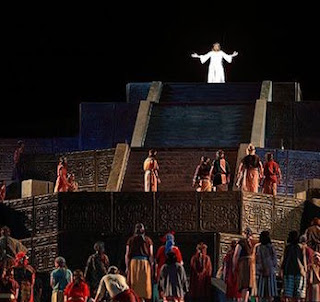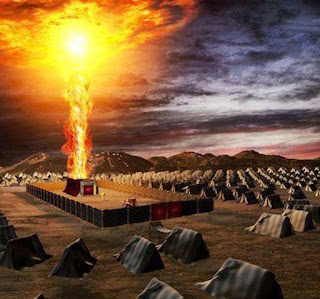10 Light Skin Bearded Gods Who Appeared in the Americas
Without a doubt, the
best outside-the-Book-of-Mormon detail on Christ visiting the Americas is here! It’s both amazing and specific! And rarely seen! It’s also got a quick summary
in #10 below!
But there are lots of
less specific accounts of a light skinned gods with beards visiting the first
inhabitants of the Americas. This does not mean that every single one of these
accounts is actually Christ. It also does not mean that each of these legends
is the same – but they all have a light skinned bearded god stopping by to say
hello.
Among other things.
Let’s start in Chile:
1) Chilean Diety-Man
The natives of Chili have the following tradition concerning one
of their culture heroes, which closely resembles Messiah as he was revealed to
the Nephites:
Resales, in his inedited (i. e. unpublished) History of Chili,
declares that the inhabitants of that extremely southern portion of America,
situated at the distance of so many thousand miles from New Spain, and who did
not employ paintings to record events, accounted for their knowledge of some of
the doctrines of Christianity by saying, "that in former times, as they
had heard their fathers say, a wonderful man had come to that country, wearing
a long beard, with shoes, and a mantle such as the Indians carry on their shoulders, who performed many miracles,
cured the sick with water, caused it to rain, and their crops and grain to
grow, kindled fire at a breath, and wrought other marvels, healing at once the
sick, and giving sight to the blind; and that lie spoke with as much propriety
and elegance in the language of their country as if he had always resided in
it, addressing them in words very sweet and new to them, telling them that the Creator
of the universe resided in the highest place of heaven, and that many men and
women who were resplendent as the sun dwelt with him. They say that he shortly
afterwards went to Peru, and that many, in imitation of the habit and shoes
which that man used, introduced among themselves the fashion of wearing shoes,
and the loose mantle over the shoulders, either fastened with a clasp at the
breast, or knotted at the corners, whence it may be inferred that this man was
some apostle whose name they do not know. (https://books.google.com/books?id=kOssAAAAYAAJ&pg=PA25&lpg=PA25&dq=The+natives+of+Chili+have+the+following+tradition+concerning+one+of+their+culture+heroes,+which+closely+resembles+Messiah+as+he+was+revealed+to+the+Nephites&source=bl&ots=jzoSWGeAXM&sig=ACfU3U3vVdouecbeT4HpOY64DbgMV6LCWA&hl=en&sa=X&ved=2ahUKEwjY7onr6briAhVJX60KHWo3B1oQ6AEwAHoECAkQAQ#v=onepage&q=The%20natives%20of%20Chili%20have%20the%20following%20tradition%20concerning%20one%20of%20their%20culture%20heroes%2C%20which%20closely%20resembles%20Messiah%20as%20he%20was%20revealed%20to%20the%20Nephites&f=false)
This is
the one almost everyone knows:
2) Quetzalcoatl
“During
the Olmec period… the great Quetzalcoatl appeared. We have seen that in the
Popol Vuh and Codex Chimalpopoca this being is represented as half-divinity,
half-hero, who who came at the head of the first Nahuas to America from across
the sea…
“…
Quetzalcoatl was a white, bearded man, venerable, just, and holy, who taught by
precept and example the paths of virtue in all the Nahua cities…
“…His
teachings, according to the traditions, had much in common with those of Christ
in the Old World…
“…He
promised to return in a future year Ce Acatl, at which time his doctrines were
to be fully accepted, and his descendants were to posses the land. Montezuma is
known to have regarded the coming of Cortes and the Spaniards as a fulfillment
of this prediction.” (https://books.google.com/books?id=l1qHkqBSso4C&pg=PA90&lpg=PA90&dq=description+of+gucumatz+beard&source=bl&ots=MMXFs4juZE&sig=rbm6bxUeLvbKLP-Ioaj7aVM0MZI&hl=en&sa=X&ved=0ahUKEwiUosfb6prbAhVH7lQKHcQWCMYQ6AEIlAEwDw#v=onepage&q=description%20of%20gucumatz%20beard&f=false)
This next one is also known as “the Weeping God” (see 3 Nephi 17:21). Two different references
below:
3) Viracocha
A) “Viracocha was the supreme god of the Incas. He is also
known as Huiracocha, Wiraqoca and Wiro Qocha. Considered the creator god he was
the father of all other Inca gods and it was he who
formed the earth, heavens, sun, moon and all living beings. When he finished
his work he was believed to have travelled far and wide teaching humanity and
bringing the civilised arts before he headed west across the Pacific, never to
be seen again but promising one day to return…
“In art Viracocha is often depicted as an old bearded man
wearing a long robe and supported by a staff. One of his earliest
representations may be the weeping statue at the ruins of Tiwanaku, close to
Lake Titicaca, the traditional Inca site where all things were first created.
Here, sculpted on the lintel of a massive gateway, the god holds thunderbolts
in each hand and wears a crown with rays of the sun whilst his tears represent
the rain.” (https://www.ancient.eu/Viracocha/)
B)
“All the Indians agree that they were created by this Viracocha, who they
believe was a man of medium height, white and clothed in a white robe gathered
around his body, and that he carried a staff and a book in his hands. After
this, they tell a strange story; that is, that after this Viracocha created all
the people, he came walking to a place where a large group had congregated …
Viracocha continued his journey, doing the works of piety and instructing the
people he had created … and wishing to leave the land of Peru, he gave a speech
to those he had created, advising them of things which were to happen in the
future. He warned them that people would come saying that they were the
Viracocha, their creator, and that the people should not believe the impostors,
but that in the coming ages he would send his messengers to teach and support
them. And having said this, he and his two companions went into the ocean and
walked away over the waters, without sinking, as if they had been walking on
land.” (https://www.lds.org/liahona/1984/01/four-peruvian-versions-of-the-white-god-legend?lang=eng)
Here’s an
interesting one – some people think he was a Viking:
4) Votan
“Votan,
appearing as the bearded "god" clothed in a long, flowing robe…
“The
actual name Votan comes from the Tzendal Maya of Chiapas. It literally means
'heart', and he was known as "the heart of the people." This deified
human reputedly kept a record of the origin of the native races, which he gave
to the guardians of a subterranean "Hall of Records" in Mesoamerica.”
(http://www.viewzone.com/votanx.html)
These stories are generally compiled by Europeans, but this
one was jotted down by a converted native. One less telephone in the telephone
game if you think about it:
5) Thonapa
Very little is now known about the author of the next legend,
except that he was an Indian from the southern sector of the Inca empire who
prided himself on having been “Christianized.” He wrote under the unwieldy name
of Don Joan de Santacruz Pachacuti Yamqui, and his manuscript, a curious
mixture of Spanish and Quechua words, remained unpublished until 1880.
Santacruz Pachacuti’s version of the white god tradition, though, is most
interesting:
“Some
years after the devils had been cast out of this land, there came to these
provinces and kingdoms of Tabantinsuyo a bearded man of medium build with long
hair, wearing a rather long tunic, and they say that he was more than a youth.
He had white hairs, was slender, walked with a staff, and he taught the people with
great love, calling them all his sons and daughters. But, he was not always
listened to nor obeyed by all the people, and when he journeyed through the
provinces he performed many miracles visibly: he healed the sick by touching
them with his hands… (https://www.lds.org/liahona/1984/01/four-peruvian-versions-of-the-white-god-legend?lang=eng)
To Brazil for
this next one!
6) Sume
Sume
of Brazil was a white, bearded man who, however, came from the east, not the
west. He introduced agriculture, and had power to raise and still tempests. The
Caboclos of Brazil persecuted him, and, before he retired from their country,
he left the prints of his feet on rocks as did Buddha in Ceylon and elsewhere…”
(https://books.google.com/books?id=6chKHROa1icC&pg=PA270&lpg=PA270&dq=Paye%C2%ADTome&source=bl&ots=70na38uhG3&sig=iG5uKVxqLNdBAOJ2IRFi6pWSCGY&hl=en&sa=X&ved=0ahUKEwj9g8T2sp3bAhUKllQKHTEvD8UQ6AEIUjAH#v=onepage&q=Paye%C2%ADTome&f=false)
Here’s
another one with Christ-like power behind him:
7) Payetome
Payetome
was also a white man…
The
apostle of the Chileans was a white man who performed miracles and cured the
sick; he caused rain to fall and crops to grow, and kindled fire at a breath. (https://books.google.com/books?id=6chKHROa1icC&pg=PA270&lpg=PA270&dq=Paye%C2%ADTome&source=bl&ots=70na38uhG3&sig=iG5uKVxqLNdBAOJ2IRFi6pWSCGY&hl=en&sa=X&ved=0ahUKEwj9g8T2sp3bAhUKllQKHTEvD8UQ6AEIUjAH#v=onepage&q=Paye%C2%ADTome&f=false)
This one,
from the north east, is phonetically pleasing:
8) Ye-Sos
An
Oneida tradition recounts the visit of a bearded, fair-skinned, white-robed stranger
who instructed them to live together in peace.
Such was the will of his father, the Great Spirit. He had been born
across the sea in a land where all men were bearded. When the Oneidas asked him what his name
was, he responded: "Ye-sos." (http://navajoministry.org/othersheep.html)
This one
specifically mentions the angelic visitor was resurrected:
9) Glooskap
“…the
Penobscot, in the Northeast, spoke of Glooskap, previously identified with
Michabo, a great teacher and miracle worker who died and was then resurrected. (https://books.google.com/books?id=8nmyq-FXXIYC&pg=PA102&lpg=PA102&dq=glooskap+%22miracle+worker%22&source=bl&ots=ftkWUczgdW&sig=wpow7VrYkdJ6jk_4Sht6YkpG6HQ&hl=en&sa=X&ved=0ahUKEwjU8drrw53bAhUaHDQIHazPDVMQ6AEIQTAI#v=onepage&q=glooskap%20%22miracle%20worker%22&f=false)
If any examples on this list deserve a source click by you, it’s this one. I linked it above but I
also linked it here. This one was compiled more recently from oral traditions by
an American-Orthadox fellow. It reinforces 3rd Nephi like nothing I’ve
ever seen. If you’ve seen better, please do share:
10) Chee-Zoos
In
the Lakota and Cherokee way of life, Wakan Tanka (Standard Lakota Orthography: Wakȟáŋ Tȟáŋka)
is the term for "the sacred" or "the divine". This is
usually translated as "The Great Spirit". However, according to Russell
Means, its meaning is closer to "Great Mystery" as Lakota
spirituality is not henotheistic. Before their attempted conversion
to Christianity, the Sioux used Wakȟáŋ Tȟáŋka to refer to
an organization of sacred entities whose ways were mysterious: thus,
"The Great Mystery". It would seem to appear that they had
already, with consideration of their culture, been Christianized by Jesus the
Christ Himself and that it had begun at the beginning of Jesus' 40 days after
His Resurrection. They tried hard to say it: Chee-Zoos, God of the Dawn Light, but
could not. Many may not want to accept this thought or idea of understanding
because of the abuses either they or others have gone through by our own white
people. I cannot blame them and neither should you. (http://www.apostle1.com/a-native-american-indian-god.html)
I’d like to stress that
this is not all the bearded, white, healing-visitor accounts out there. And I’d
like to double-stress that I’m not convinced ‘white’ means ‘Caucasian’
in these stories.
These are all a
thought-provoking read when they’re lumped into a fast blast like this. Could
these be the other sheep Christ referenced when he left his apostles after the resurrection
in John 10:16. Possible post resurrection visits hinted at there are not recorded
anywhere else.
If you haven’t already,
here’s a final account: 3 Nephi Chapter 11 in the Book of Mormon. It starts a
pretty long visitation account of Christ in the Americas. Read it, then read
these 10 again.
It’s fascinating.











Comments
Post a Comment